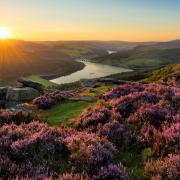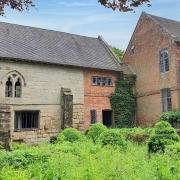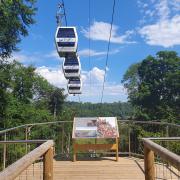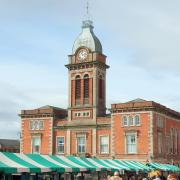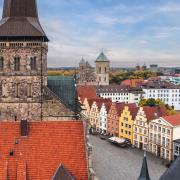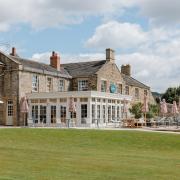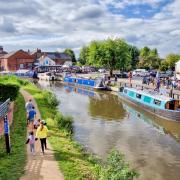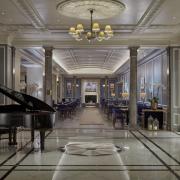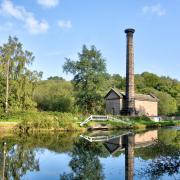It’s 50 years since Andrew and Vanessa Pugh took over The Heights of Abraham, transforming the once tired and run-down hilltop estate into the sustainable and unique visitor attraction it is today.
The introduction of the alpine style cable car system at The Heights created quite a stir 40 years ago; the first passenger system of its kind in the UK.
This double anniversary year, ‘Golden’ and ‘Ruby’, marks a period of reflection for the couple and their extraordinary love story, their long and successful marriage and working partnership.
It was Andrew’s decision to put a stop to his high-octane sporting career to build a new life for them to enjoy together which led to their lives being changed in a most unexpected way.
Fate appeared to lead them here, in a part of the country neither had visited before, and this was to become their lives’ work.
It’s a tale of hard work, commitment, determination, ingenuity and bravery – with a dose of serendipity thrown in.

LIFE IN THE FAST LANE
The son of a successful line of Bristol grocers, Andrew felt upon entering the family business he was ‘set for life’.
The business was long established and had weathered the damage to the city during the Second World War. His mother, however, had different ideas and encouraged him to embark upon a corporate career with Unilever, expanding a new brand within their portfolio, Bird’s Eye.
Loving his new role and the freedom it allowed, Andrew made sure he allowed time for his sporting passion - motorsports.
A keen amateur racing driver, his confidence, skill and daredevil nature soon meant he was driving a Morgan supported by the marque’s founder Peter Morgan himself, as well as powering circuits in his beloved Mini Cooper.
He fulfilled his dream to race at Goodwood but that same day a dramatic incident occurred which led him to step aside from the track, realising the risks he was taking, and focus on his career.
He wasn’t out the game long when another equally risky sporting pursuit, power boat racing, captured his attention.
With the encouragement of a friend, he embraced it with natural ease, and enjoyed much success. The sport was heavily sponsored in those days, allowing Andrew a chance to leave his job. It was the early 70s and tobacco brands were generous.
Despite being a non-smoker, Embassy counted Andrew as one of their two sponsors in the sport. With events across Europe’s most glamorous cities, and the winter season spent in South Africa, his flat in central London tended to be a mere pitstop.
Vanessa’s parents had moved to East Africa in 1939 where her father was the senior partner of the major law firm in Uganda.
She was born in Kampala, educated in Kenya and Switzerland and moved to London to study law, before heeding her mother’s advice to take secretarial training. It wasn’t long before her bright mind and charming personality led to her enjoying the cream of PA jobs in the city.
Through mutual friends and an opportune gap in Andrew’s event schedule, the two met at a mutual friend’s dinner party, and before long become romantically paired.
Andrew still recalls, with a twinkle in his eye, how Vanessa’s infectious laughter melted his heart completely.
THE PLEDGE
The couple’s early courtship was a whirlwind of Europe’s most glamorous resorts and London.
However, it become clear to Andrew after their relationship grew that despite his love of speed and competition racing, he loved Vanessa more.
Dedicated to the idea of them enjoying a long and happy lifetime together, he quit his sporting lifestyle. Fatalities among his sporting peers were high and he concluded that for him to commit wholeheartedly to Vanessa, he needed to have a life in the first instance!
Together, they pledged to spend as much time together as they could, and as part of this plan would seek a business opportunity to run as a partnership.
Both were bright and creative thinkers and willing to put in hard work. Both ‘people persons’, this attribute was to serve them well as their vision unfolded.
SEALING THE DEAL
As though fated, a classified ad appeared in The Daily Telegraph, for ‘a most unusual business, a place with woods, caves, and a House.’ Intrigued, the couple found themselves one rainy Sunday in February driving from London to Matlock Bath and knocking on the vendor’s door.
Although enchanting, the neglected hilltop estate and old-fashioned home were not for the faint-hearted, and there was much work to be done.
Yet, seeing the potential, Andrew and Vanessa were ‘sold’. With the enthusiasm and gusto of youth, the couple were soon shaking hands on the deal, agreeing to take over for Spring Bank Holiday 1974.
THE INAUGURAL SUMMER
That first summer, with a lot to learn and a need for immediate cash flow, Andrew and Vanessa ran the business pretty much as the previous owners had established.
Although rather run down and the pathways dilapidated in places and non-existent in others, one part attracted a brisk local trade - The Tavern, a pub on the estate originally licensed to benefit the mid-18th century lead miners.
Enjoying longer opening hours than the pubs in Matlock Bath, due to its historic beer laws, customers enjoyed the extra drinking time up at The Heights.
The simple catering was also a money-spinner. Vanessa laughs, recalling one favourite recipe, a ‘Belgian biscuit cake, easy to make and the visitors loved it!’
Back then, the food was prepared by Vanessa, with help from her family who had relocated from Kent – a blessing, as it was all hands to the deck.
Meanwhile, there were plenty of logistical nightmares to keep Andrew occupied, such as wheeling barrels of beer up to the Tavern on unmade paths.
As that first season came to an end, the couple travelled abroad to be married and, thanks to friends in South Africa, were generously hosted to enjoy an extended honeymoon.

THE FIRST DECADE
Early in 1975 they returned, refreshed by their winter honeymoon, to embark on what was to become a ten-year project of restoration.
It was not purely the visitor attraction and grounds that needed urgent repair, it was their antiquated home too.
There was no central heating and a roof which required the back up of buckets each time it rained which, in Derbyshire, was quite often!
Work was soon underway to improve the estate’s infrastructure, rebuilding the Victoria Prospect Tower, re-routing power cables underground, and restoring old pathways.
They soon recognised the special qualities of their estate - its distinctive topography and geology and fascinating social history was a unique asset.

This encouraged the Pughs to work with the Countryside Commission, granting the Estate Grade II protected status.
Andrew was also inspired to become a Board Member of the East Midlands Tourist Board, where he garnered influential contacts and exchanged ideas with other leading businesses.
When the Great Rutland Cavern underwent its major transformation, its launch attracted a Royal visit, The Duke of Gloucester, who came to support the project in its beautiful setting.
The Duke’s security team were, recalls Andrew, somewhat challenged by the precarious vehicular access up the steep drive.
On the brink of admitting defeat, their caution was put to shame by Mrs Pugh merrily returning from the shop, traversing that same driveway in her sportscar.
During the 70s, the estate was vastly improved, as the family and their close-knit employees ploughed on, even regenerating the flora and fauna, restoring what had been known as the ‘savage gardens’. It was during this time the couple expanded their family, welcoming their son Rupert, born in 1976.

Cash was often tight as they were constantly ploughing money back into developing the estate. At times it was tempting to mirror the arcades of Matlock Bath.
This would have secured substantial cashflow, yet they were mindful of what would be in the best interest of the estate, their local community, and the surrounding Peak District National Park.
Into the 80s, visitor numbers were challenged as new attractions, such as Alton Towers and Center Parcs, transformed the leisure market, raising the bar of customer expectations.
Quite simply, folk were less willing to put in the legwork to visit the Heights. Future plans relied upon improving accessibility. Andrew and Vanessa’s creativity and imagination was ignited – and an adventurous idea was in the pipeline.

A MAJOR CHALLENGE…
Inspiration struck, and one winter’s evening in 1982 Andrew and Vanessa sat with a map of the estate, the village, pens and a ruler.
Busy plotting a course for a visionary cable car ride, which would transport visitors from the main hub of the village where the railway station and coach park were, up the Heights, via the best path of ‘no houses’. But where to begin?
With the start of the summer season 1984 in mind, they had ten months to secure outline planning permission, architects’ plans, support from the District Council, English Tourist Board, not to mention sourcing a cable car system from Europe, watertight legal back up and several investors to raise the huge sum of finance.
Unbelievably, project plans were assembled within the necessary timelines – involving several European cable car specialists, more used to alpine slopes.

It was French firm Pomagalski (Poma) that won the contract. Initially, this world-class engineering and manufacturing company were somewhat dismissive of the seemingly small project.
The financial backing was complex, with several banks and investors to win over. The legalities were complex too, with a language barrier and different cultures and legal systems to navigate.
There were a couple of occasions Andrew and Vanessa felt their dreams were dashed, but they kept going. Eventually, contracts were signed and the contractors broke ground that very day.
Despite meticulous plans, Poma were slow in making a start. What they viewed as a relatively small system with just twelve cable cars, construction of the system was extremely complex due to the estate’s location.

The Derwent Valley was unfamiliar terrain, and densely wooded areas on the hillside, and the traversing of a busy public road, river, and a railway saw progress stall.
With limited vehicular access, a helicopter was employed to lift sections of the towers into place – a dangerous and precarious task with the length and vast weight of the metal struts, and a helicopter pilot more used to manoeuvres on the oil rigs of the North Sea, where there are no trees to navigate.
Such was the Herculean task, the Treetops Visitor Station, designed to welcome visitors from their journey in the new cable car system, was also delayed, allowing just a nine-day turnaround to deck out its interiors in time for the grand opening.
On April 21, as planned, the visitor attraction launched its alpine cable cars to the delight of visitors, some of whom dressed up in Victorian-style fancy dress to secure free entry on the day.
The Heights dazzled in the glare of the media spotlight – a TV documentary followed by national and regional radio, television and newspapers all wanting to showcase this extraordinary accomplishment - the first cable car attraction of its kind in the UK.

THE REST IS HISTORY
April marked the Ruby anniversary of the opening of the cable cars, a pivotal point in the ongoing story of this unique and ever-evolving attraction, still privately owned by the Pugh family.
The award-winning Estate is now managed by Rupert who, along with wife Sophie, have a young family of their own.
Andrew and Vanessa, now in their 80s, still take great interest in the running of the Estate, which is also their family home.
This year promised to be an especially vibrant season, with this anniversary year attracting more visitors to enjoy a fun-packed calendar of seasonal and celebratory events, which for the first time will extend the season to the year end.







